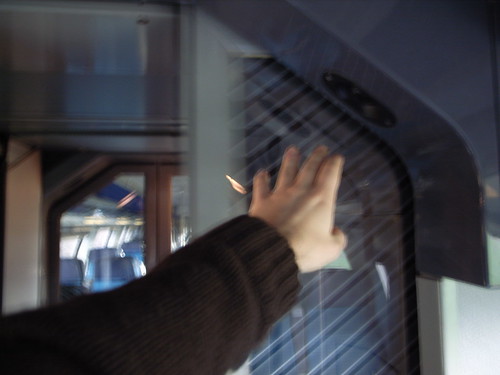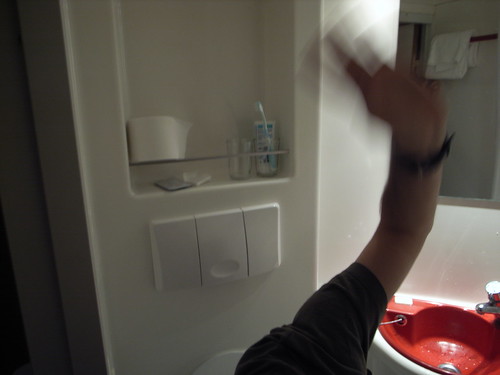Last week I had two interesting encounters with gestural interactions. The first one was in the super-fancy double decker train that goes from Geneva to ZanktGallen/Zurich. In that train, there is a sensor to open up the doors between wagons. People, if they're slow or if they don't know that there's a sensor generally walk in, wait a bit and then come in as the door opens up when the sensor detect the presence of a body. But usually, commuters know that they can wave their hand next to the sensor as I did here (very weirdly with the left hand):

In other trains, the sensor is situated on the floor. Standing next to this door during the whole trip to Zürich was a fantastic opportunity to observe the range of behavior in that kind of situation. I did not count or ran precise analysis but I tried to categorize these behavior in a sort of ludicrous way: - old people clueless about the sensor presence but slow enough to see the door opened when they approach it - people who knows that there's a sensor, so they wait and go through the door - commuters well-versed into swiss train sensors who wave their arm - people in the rush who almost run and bump into the door because the sensor did not have time to detect the body - commuters who know how the sensor works, wave the arm and fail to open it (for some reason... because technology sucks), so step back and try again 1 or 2 times. A variant is when you have people then looking at the sensor, sometimes talking to it. - one person even try to open the door manually but he failed because there is no clear handle (nor affordance) to do so. He the looked at me and sighted.
Quite an interesting list and I am sure there can be other curious use case as I haven't seen kids or people with loads of luggage. The underlying variables here are the following: the location of the sensor, its visibility and affordance to the user as well as the delay between body detection and opening of the door. It was obvious that all of them were problematic.
The second encounter was in Brussels, in an hotel loo, there was a sensor that detect a body presence to switch on/off the light. What happened inevitably is that the light went off and I found myself waving my arms here and there... eventually above my head... because I did not know where was the sensor. What happens? Who tuned the sensor? How did they tune that bloody sensor? Did they run user studies about how people spend time in bathrooms? In any case, what happened is that they created a sort of norm in that building, that tell people how long they must or must not stay there. The whole experience then becomes weird although I can adapt and find funny to wave my arm around.
Why do I blog this? there are two interesting aspects here: the mix of gestural sensing and automation. All of this is based on the assumption that the best way to interact with technology is to make things more naturals, more physical by removing any transducers between people and artifacts. No buttons, no switches to open doors or switch lights on. In a sense there is still an interface, that is gestural but as it is no self-revealing, people have troubles knowing what to do. And you have, on top of that, the clumsy automation issue: automation indeed create new operational complexities as shown by Wood.
On that topic, see also Fabien's experience as well as Fabio Sergio's story. Clive Grinyer has good thoughts about it too.
